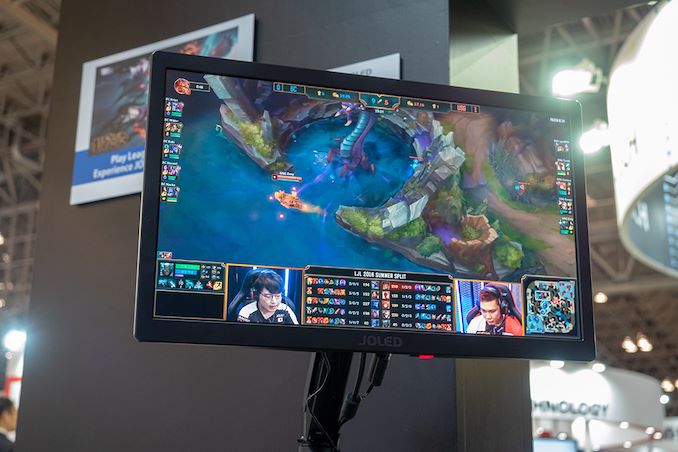JOLED Starts Trial Production of Printed OLED Sheets at 5.5G Plant
by Anton Shilov on November 26, 2019 4:00 PM EST
JOLED has started trial production of printed OLED substrates at its 5.5G plant at its Nomi Site, which was officially completed on Monday, November 25. The sheets will be used to make high-resolution mid-size OLED displays in 2020, when the factory starts mass production.
JOLED’s 5.5G facility has a monthly production capacity of 20,000 1,300×1,500-mm substrates, which are processed using the company’s own high-speed printing method. Based around batch EL layer formation, JOLED's process is said to greatly improve productivity, which the company hopes will eventually give them an edge in producing cheaper OLED panels.
JOLED started to build its 5.5G OLED plant in July 2018, and aims to start volume production at the facility in 2020. Right now, the factory is producing samples, which will be sent to JOLED’s customers. The plant is located near Nomi in Ishikawa Prefecture in Japan.
Having inherited the OLED operations of Sony and Panasonic, JOLED currently uses a 4.5G production line near Nomi to make its printed OLED screens. That fab is considerably smaller than the new one, which limits the development of the company’s business.
Related Reading:
- JOLED Starts Construction of New Printed OLED Facility
- JOLED Demos 21.6-Inch OLED Monitor for Gamers
- EIZO Reveals Limited Edition 21.6-Inch Foris Mova OLED Monitor
- ASUS ProArt PQ22UC 4K OLED Monitor: £4699, ~$5150
Source: JOLED











19 Comments
View All Comments
DanNeely - Tuesday, November 26, 2019 - link
What exactly are "mid-size" displays? Phones are obviously small, and >50" TVs large; but is mid-size tablet screens, laptop screens, or desktop monitor screen size panels?mrvco - Tuesday, November 26, 2019 - link
Bigger than a breadbox, smaller than a barn door!deil - Wednesday, November 27, 2019 - link
that's about accurate. small is phone or watch. big is the billboard that spans half of the soccer field.dullard - Tuesday, November 26, 2019 - link
Given that the article mentions that it is printed on substrates that are 1.3 m x 1.5 m, I would say that it would be any screen smaller than that substrate size. That translates to smaller than 78" diagonal.psychobriggsy - Wednesday, November 27, 2019 - link
Substrate is 1.3mx1.5mDisplays will be cut from that to minimise wastage.
Theoretically that means a 66" diagonal display (full substrate), 4 33" displays, 9 22" displays or 16 16.5" displays. There's probably a bit of wastage around the edges, so this matches very well to common consumer displays - laptop 16", desktop 21", desktop 32" and TV 65".
stepz - Thursday, November 28, 2019 - link
2 55" displays would have close to zero wastage.Kamus - Wednesday, November 27, 2019 - link
It would be larger than tablet or small laptop screens. Think desktop monitor sizes.The only reason Samsung doesn't make OLED televisions is because the process they use to make other screens doesn't scale well to bigger sizes (than tablet sizes-small laptops) as the yields take a huge hit the bigger the screens get.
nathanddrews - Tuesday, November 26, 2019 - link
As long as we're wishing for stuff, how about a 30-40" 1440p 480Hz HDR OLED monitor?lilkwarrior - Tuesday, November 26, 2019 - link
1440p is not profitable enough to simultaneously cater to prosumers. 4K @120hz is the way to go for OLED panels.boeush - Tuesday, November 26, 2019 - link
If you're talking about a desktop monitor, for 1440p just about the optimal size is 27": any bigger, and you'll be seeing individual pixels at arm's-length viewing distance. At 40", you want 4k: it's exactly like a 2x2 grid of full-HD 20" screens ...